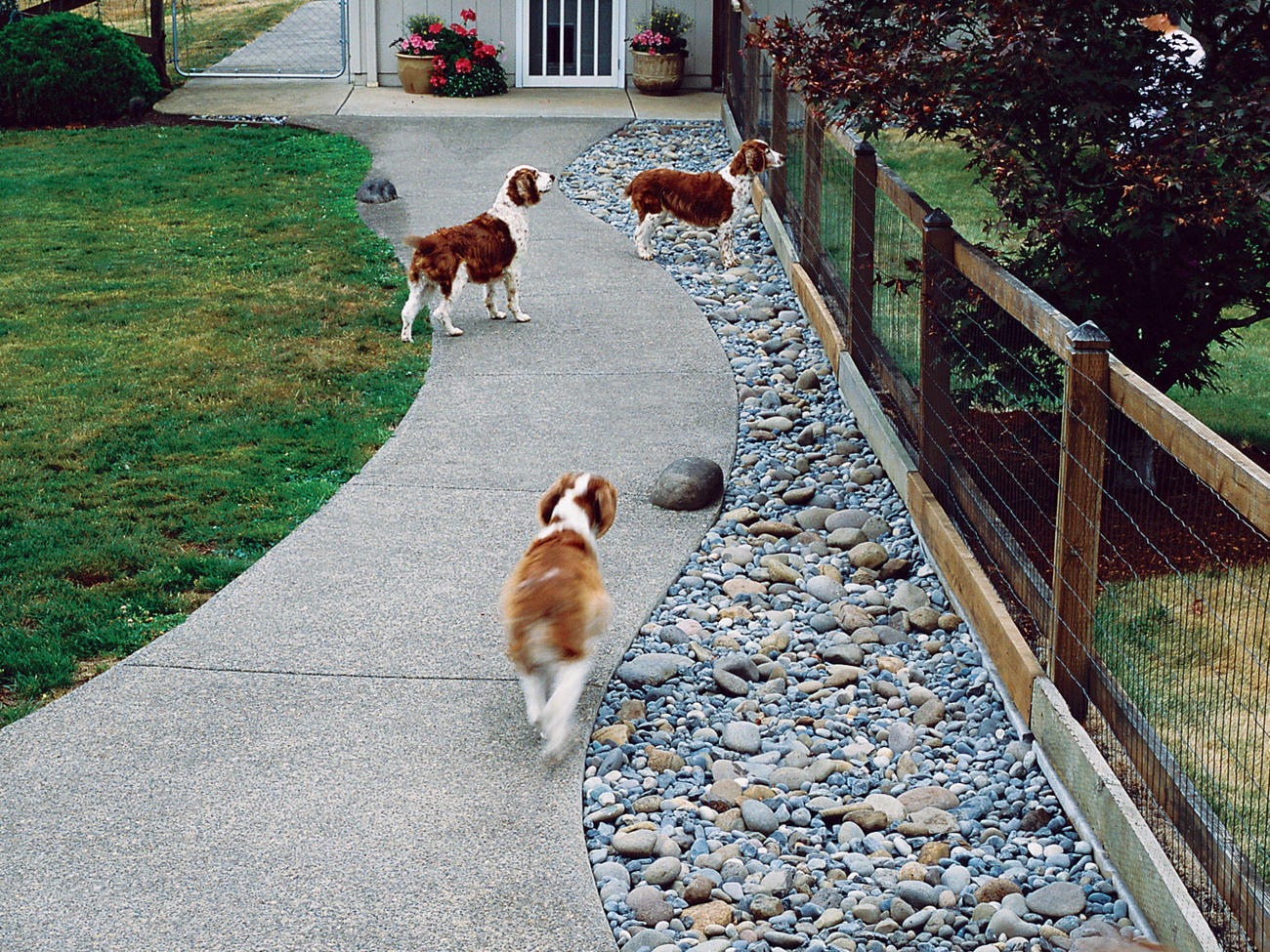
Q&A: More Help for Dog-Friendly Gardens

Q: Can you recommend a good book on dog-friendly gardening?
A: For a practical and thorough overview, check out Dog Friendly Gardens, Garden Friendly Dogs (Dogwise Publishing, 2004; $20; dogwisepublishing.com or 800/776-2665), by Cheryl S. Smith.
Q: What are foxtails, and why are they dangerous to dogs?
A: Foxtails are weed grasses commonly found growing wild in open spaces and in unkept gardens. The danger comes from their barbed awns or tips, which can work their way under the skin between a dog’s paws and toes and cause infection. Even worse, the awns can migrate down the ear canal, causing severe pain and potential hearing loss, or can be inhaled into the nasal cavity and migrate to the lungs.
Q: How can I keep my dog from digging in the garden?
A: Filling a hole with a dog’s own feces will keep it from digging in that spot again, says veterinarian Darla Jochum of Jacksonville, Oregon. But it won’t keep your pet from digging elsewhere.
Jochum suggests setting aside a place where this activity is allowed, such as a sandpit or sandbox. If you happen to own a Jack Russell or other terrier, this is especially advisable. They were bred to hunt burrowing animals. So trying to get them to stop digging altogether is not realistic, says Jochum.
Position the sandpit in a shaded area, away from sprinklers. Bury a few dog biscuits and toys when your pet is not around. Then bring your dog to the pit, do a little digging yourself to demonstrate, and encourage your pet to join you. Lots of praise and occasionally restocking the treats will keep your dog interested.
Q: Can you recommend a few sturdy plants that stand up to dogs?
A: Bud Stuckey, Sunset’s test garden coordinator, has had good luck with the following plants in his own landscape: African boxwood, artemisia, canna, ginger, lilac, New Zealand flax, ornamental grasses, osmanthus, pines, strawberry tree, and Western sword fern.
Readers recommend: agapanthus, asters, butterfly bush, campanula, cistus, columbine, heuchera, honeysuckle, lavatera, liriope, mock orange (Philadelphus), pieris, spiraea, thrift, and violas.
Q: I’ve been told to avoid plants that attract bees. Does that mean I have to give up my favorite plant, lavender?
A: That depends on your dog. If you have a dog that likes to snap at and eat flying insects, planting lavender, rosemary, or other bee-magnets is not a good idea, says veterinarian Steven Randle of Pacifica Pet Hospital in Pacifica, California. Insect bites are almost inevitable, and while most dogs will develop nothing more than a swollen muzzle, others can experience anaphylaxis, a life-threatening allergic reaction.
On the other hand, many readers wrote telling us how much their dogs enjoyed rubbing up against these plants. So obviously some dogs coexist with stinging insects without problems.
A possible compromise is to enjoy the aromatic foliage of lavender but shear off the bee-attracting flowers.
Q: Are there emergency first-aid items I should have on hand for my dog?
A: Randle advises dog owners to keep a list of phone numbers for several backup veterinarians as well as the number for an emergency veterinary clinic. Having some Benadryl (Diphenhydramine HCl) around in case of a beesting is also a good precaution (buy it in pill form, and contact your veterinarian for the correct dosage for your dog’s weight). You’ll still want to take your pet to a veterinarian quickly if the sting is severe, advises Randle, but Benadryl can buy you time.
Like humans, dogs enjoy basking in the sun. So by all means, give them a deck or a patch of lawn for sunbathing. But remember that dogs can overheat easily, so it’s even more important to provide them with cooling retreats. Here, 4 retrievers (liko, Lexi, Andy, and Morgan) enjoy resting under an arbor in Oceanside, CA.
Q: Products are available that change the pH of dog urine to prevent it from burning lawns. Do they really work, and do they have any side effects?
A: “From the reports I get, these products are not very effective,” says Randle. “They are probably safe for most dogs, but I would avoid them completely if your dog has ever had a urinary-tract problem or if you have a breed that is predisposed to urinary stones, like the Dalmatian.”
Instead, try watering the spot where the dog urinated to dilute the nitrogen, says Stuckey. This helps reduce the amount of yellowing. Letting your lawn grow 3 to 4 inches tall, as Stuckey does, also hides a few imperfections.
Q: Is it safe to use chemical fertilizers, herbicides, and pesticides if you have dogs?
A: “There is no scientific evidence that chemical fertilizers/pesticides induce any form of cancer in dogs,” says Randle. “However, veterinary oncology is a relatively new science, and we don’t know the cause of the majority of cancers in animals. So if you don’t feel safe using chemicals around your family, don’t use them around your pets. I do see many more animals suffering from diseases caused by insects than I do from insecticides.”
It is a wise precaution, however, to keep your dog off a recently sprayed lawn until the grass has thoroughly dried, usually 24 hours.
Q: Dogs seem to enjoy looking out through “windows” in fences or gates, but some people say that solid fences keep dogs from barking. Is that true?
A: “Due to the acute sense of smell and hearing in our canine companions, it makes little difference whether a fence or gate is solid or transparent,” says Randle. “Dogs will still bark at what’s on the other side of the barrier.”
You should ensure, however, that slats or other separations in the fence are close enough together that your dog won’t get its head stuck between them if provoked by another animal or human.
